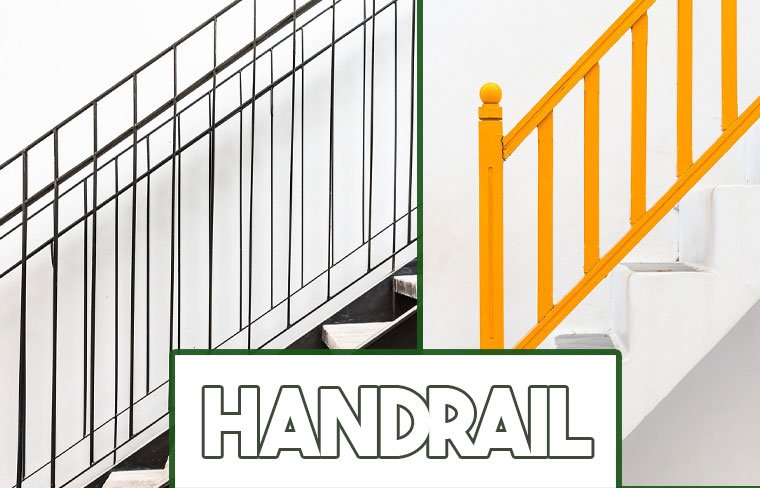Are you curious about the variety of handrails available for your stairs and wondering which one is the best fit for your home?
The handrail is often an overlooked aspect of staircase design, yet it plays a important role in both the aesthetic and functional aspects of your home. With a range of options available, from traditional wooden handrails to modern glass and cable alternatives, selecting the right handrail can be a challenging task.
This comprehensive guide aims to help you navigate the diverse world of handrails, offering insight into the various types, designs, and considerations to help you make the best choice for your stairway.
With a variety of handrail options available, each offering unique benefits and aesthetics, understanding their features is key to making an informed decision. This guide will explore the main types of handrails, including wooden, metal, glass, and cable, highlighting their characteristics, design possibilities, and safety considerations, to assist individuals in choosing the most suitable option for their stairs.
Introduction
Handrails are an essential component of staircase safety, providing support, stability, and assistance with balance. Beyond their functional role, handrails also contribute significantly to the overall design and aesthetic of a stairway. With a wide array of options on the market, it can be a daunting task for homeowners to select the most appropriate handrail for their needs. This article aims to simplify this process by offering a detailed exploration of the various handrail types, their unique features, and the key considerations to keep in mind when making a decision.
Main Types of Handrails
1. Wooden Handrails:
Wooden handrails offer a classic and timeless look, providing a warm and natural feel to any stairway. They are a popular choice due to the versatility of wood, allowing for a range of designs, from traditional to modern styles. Wooden handrails are often paired with a variety of balusters and newels to create a customized look.
2. Metal Handrails:
Metal handrails, including aluminum, steel, and wrought iron options, provide a sleek and modern aesthetic. They offer durability and strength, making them ideal for both indoor and outdoor use. Metal handrails can be designed with various finishes, such as brushed, polished, or powder-coated, to suit different decor styles.
3. Glass Handrails:
Glass handrails offer a contemporary and elegant alternative, providing a sense of openness and light to any space. They are often chosen for their ability to showcase the staircase design and create the illusion of a larger, more spacious area. Glass handrails can be frameless or framed, and utilize tempered or laminated glass for safety and durability.
4. Cable Handrails:
Cable handrails are a unique and modern option, offering minimal visual obstruction and a sleek, industrial aesthetic. They are typically made from stainless steel or aluminum cables, providing durability and a distinctive look. Cable handrails are an excellent choice for showcasing the beauty of the staircase structure while providing a secure grip.
Wooden Handrail Varieties
1. Traditional Wooden Handrails:
Traditional wooden handrails evoke a sense of classic elegance and warmth. They are often characterized by intricate details, such as turned balusters, carved newels, and ornate designs. Traditional handrails are typically crafted from hardwoods like oak, maple, or cherry, ensuring durability and a rich, natural grain pattern. These handrails can be stained or painted to match the surrounding decor and are ideal for homes aiming for a classic or rustic aesthetic.
2. Modern Wooden Handrails:
Modern wooden handrails offer a more contemporary take on the traditional style. These handrails often feature clean lines and simple, minimalist designs. Floating or wall-mounted handrails are popular choices, providing a sleek and sophisticated look. Modern wooden handrails can be crafted from a variety of woods, including lighter options like birch or pine, and stained or painted to match the desired color palette. This style is perfect for homes embracing a more current or transitional design aesthetic.
3. Wooden Handrail Materials:
The type of wood used for a handrail can significantly impact its appearance and durability. Hardwoods, such as oak, maple, and cherry, are popular choices due to their strength, beauty, and ability to withstand wear and tear. These woods offer a rich grain pattern and can be easily stained to enhance their natural beauty. Softer woods, like pine or cedar, may be used for a more economical option, but they require more frequent maintenance and may not be as durable over time.
Metal Handrail Varieties
1. Aluminum Handrails:
Aluminum handrails offer a lightweight yet durable option for metal handrails. They are corrosion-resistant and ideal for both indoor and outdoor use. Aluminum handrails can be designed with various finishes, such as anodized or powder-coated, to create a modern or traditional look. This material is easy to work with and can be customized to fit unique stairway designs.
2. Steel Handrails:
Steel handrails provide exceptional strength and durability, making them a popular choice for both residential and commercial spaces. They offer a sleek and modern aesthetic and can be customized with different finishes. Stainless steel, in particular, is highly resistant to corrosion and stains, making it a low-maintenance option. Steel handrails can be welded or fabricated to create seamless joints, ensuring a smooth and elegant appearance.
3. Wrought Iron Handrails:
Wrought iron handrails offer a classic and elegant look, often featuring intricate scrollwork and detailed designs. This material is known for its strength and durability, making it ideal for both indoor and outdoor applications. Wrought iron handrails can be customized with various finishes, such as blackened iron or painted options, to suit the desired aesthetic. They are a perfect choice for traditional or rustic-style homes.
4. Metal Handrail Finishes:
Metal handrails can be finished in a variety of ways to alter their appearance and protect the underlying material. Brushed finishes create a soft, satin-like surface, while polished finishes provide a high-shine, mirror-like appearance. Powder coating is another popular option, offering a durable and long-lasting finish in a range of colors. Other finishes like antiquing or patina can add a unique, aged appearance to the metal handrail.
Glass Handrail Varieties
1. Frameless Glass Handrails:
Frameless glass handrails offer a contemporary and minimalist look, providing unobstructed views and a sense of openness. These handrails are typically made from thick, tempered glass for safety and durability. Frameless designs create a seamless and elegant appearance, showcasing the beauty of the glass itself. This style is ideal for modern homes or spaces where natural light is a priority.
2. Framed Glass Handrails:
Framed glass handrails provide a more traditional or transitional look, offering a combination of glass and metal or wood. The frame adds a sense of structure and stability, while the glass panels provide a light and airy feel. Framed glass handrails can be customized with various frame and glass options to suit the desired aesthetic. This style is versatile and can complement a range of decor styles.
3. Glass Handrail Materials:
Tempered glass is the most common material used for glass handrails, offering increased strength and safety. This type of glass is heat-treated to withstand impact and breakage, making it ideal for high-traffic areas. Laminated glass is another option, consisting of two layers of glass bonded together with a plastic interlayer, providing enhanced safety and security.
Cable Handrail Varieties
- Cable Railing Systems: Cable railing systems utilize horizontal or vertical cables to create a secure and modern handrail. These systems typically feature stainless steel or aluminum cables, providing durability and a sleek, industrial aesthetic. A cable railing is an excellent choice for showcasing the beauty of the surrounding architecture while providing a secure grip and minimal visual obstruction.
- Cable Handrail Materials: Stainless steel cables are a popular choice for cable handrails due to their strength, durability, and corrosion resistance. They offer a sleek and shiny appearance, complementing modern or industrial designs. Aluminum cables are another option, providing a lightweight and cost-effective alternative while still offering durability and a range of finish options.
Handrail Design and Style Considerations
1. Matching Handrails to Home Decor:
When selecting a handrail, it is essential to consider the overall design and decor of your home. For a cohesive look, choose a handrail style that complements the existing architecture and design elements. For instance, a traditional wooden handrail with ornate details may suit a classic or rustic home, while a sleek, frameless glass handrail could enhance a contemporary space.
2. Modern, Traditional, or Rustic Designs:
The design of the handrail should align with the desired aesthetic of the space. Modern handrails often feature clean lines, minimalist designs, and the use of materials like glass or metal. Traditional handrails may incorporate more intricate details, turned balusters, and hardwoods. Rustic designs might favor wrought iron or natural wood handrails with a distressed or aged finish.
3. Customizing Handrails for Unique Stairway Designs:
For stairways with unique designs or architectural features, customizing the handrail can enhance the overall impact. Custom handrails can be designed to fit unusual shapes, incorporate unique materials, or showcase one-of-a-kind details. Working with a skilled craftsman or fabricator can ensure that the handrail complements the stairway’s design while providing the necessary functionality.
Safety and Building Code Considerations
- Building Codes and Regulations: When installing a handrail, it is important to ensure compliance with local building codes and regulations. These codes often specify requirements for handrail height, width, spacing, and protrusion to ensure safety and accessibility. Understanding and adhering to these codes is essential to avoid legal issues and ensure the safety of those using the stairway.
- Safety Considerations: Handrails play a vital role in stairway safety, providing support and stability. When selecting a handrail, consider factors such as grip, durability, and the ability to withstand wear and tear. Proper installation is also key to ensuring safety, including secure fastening and correct positioning to provide adequate support.
- Consulting Professionals: For complex installations or unique stairway designs, consulting with professionals, such as architects or contractors, can ensure that the handrail meets safety standards and building codes. These experts can guide you in selecting the most suitable handrail for your specific needs and help navigate any compliance requirements.
Conclusion
Selecting the right handrail for your stairs involves considering various factors, from safety and functionality to design and aesthetics. This guide has provided an in-depth exploration of the main types of handrails available, highlighting the unique features and benefits of each. Whether you prefer the classic warmth of wooden handrails, the modern elegance of glass, or the industrial charm of cable handrails, there is an option to suit every taste and stairway design.
As a final thought, remember that installing a handrail is not just about enhancing the visual appeal of your stairway but also ensuring the safety and comfort of those using it. Consulting with professionals can help you make the best choice for your specific needs and ensure a seamless and secure installation. With the right handrail in place, you can add both beauty and functionality to your home, creating a space that is not only stylish but also safe and welcoming.




No Comment! Be the first one.